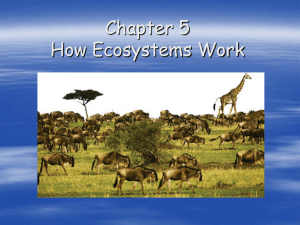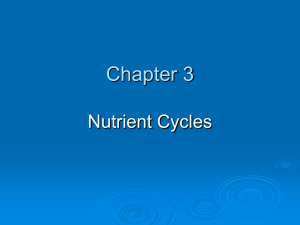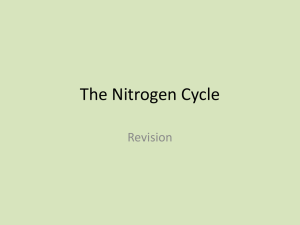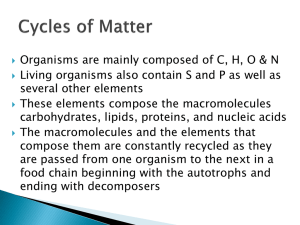Nitrogen Fixation: Nitrogen fixation is one process by which
advertisement
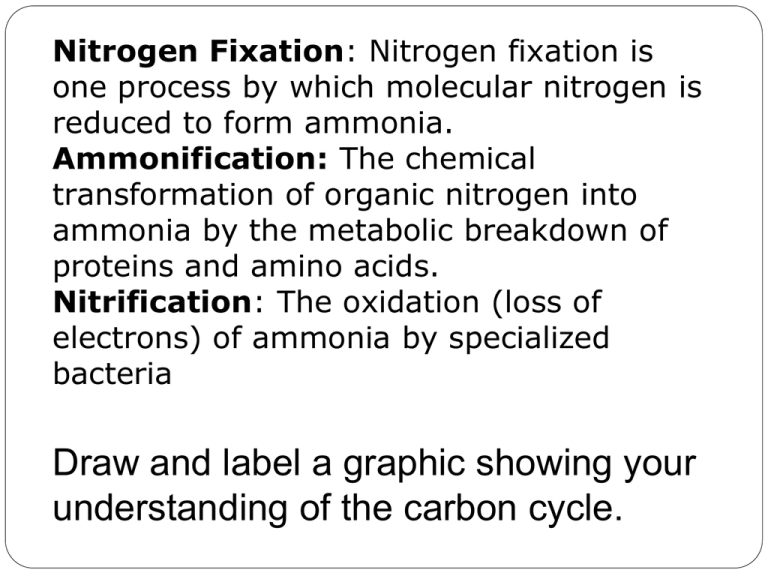
Nitrogen Fixation: Nitrogen fixation is one process by which molecular nitrogen is reduced to form ammonia. Ammonification: The chemical transformation of organic nitrogen into ammonia by the metabolic breakdown of proteins and amino acids. Nitrification: The oxidation (loss of electrons) of ammonia by specialized bacteria Draw and label a graphic showing your understanding of the carbon cycle. Nitrogen Cycle Why is nitrogen important to organisms? Organisms use nitrogen to carry out life functions Nitrogen is an important component of DNA, RNA, proteins, and chlorophyll Nitrogen Cycle The earth’s atmosphere is composed of almost 80% nitrogen, but it is mostly in the form of nitrogen gas (N2) N2 is unavailable to plants and hence to consumers of plants Nitrogen Cycle Nitrogen Cycle Lightning discharges convert some of the molecular nitrogen into forms that plants can use Most nitrogen in the atmosphere enters the biological pathways of the nitrogen cycle through nitrogen fixation Nitrogen Fixation Biological absorption of atmospheric nitrogen to form organic nitrogen containing compounds Nitrogen fixation is one process by which molecular nitrogen is reduced to form ammonia Ammonification Plants obtain nitrogen from the soil either as ammonium or as nitrate With an input of energy, plants reduce nitrogen to an organic form such as ammonium Organic nitrogen is the most reduced form of the nitrogen atom, with the highest potential chemical energy Organic nitrogen is used to construct proteins Ammonification Proteins are eventually metabolized (broken down to yield energy) Excess nitrogen is excreted into the environment as waste Hydrolysis: A chemical process that splits molecules by the addition of water Oxidation: The loss of elections from a substance involved in a redox reaction Redox Reaction: A chemical reaction involving the transfer of one or more elections from one reactant to another Ammonification Ammonification occurs through the breakdown of proteins into amino acids by hydrolysis and oxidation of the carbon in those amino acids This process results in the production of ammonia Ammonia is usually transformed to ammonium Nitrification Nitrification: The oxidation (loss of electrons) of ammonia by specialized bacteria Nitrification yields nitrite and nitrate Oxidation steps release much of the potential chemical energy of organic nitrogen Each step is carried out by specialized bacteria Denitrification In water-logged anaerobic soils and in oxygen depleted bottom waters, organic matter is broken down through denitrification Nitrate is converted back to atmospheric nitrogen Nitrogen Fixation The loss of readily available nitrogen through denitrification is offset by nitrogen fixation Nitrogen fixation is accomplished by specialized bacteria (prokaryotes) Azobacter: a free living species Rhizobium: occurs in a symbiotic relationship with the roots of some legumes Nitrogen Fixation Convert atmospheric nitrogen to minerals that can be used to synthesize nitrogenous organic compounds Some cyanobacteria fix nitrogen in aquatic ecosystems Organisms that fix nitrogen are fulfilling their own metabolic requirements, but the excess ammonia they release becomes available to other organisms Nitrogen Fixation The direct product of nitrogen fixation is ammonia Most soils are at least slightly acidic, and ammonia released into the soil picks up a hydrogen ion to form ammonium Ammonium can be used directly by plants Nitrogen Fixation Ammonia is a gas and can evaporate back into the atmosphere Ammonia lost from the soil may then form ammonium in the atmosphere As a result, ammonium concentrations in rainfall are correlated with soil pH over large regions Most of the ammonium in the soil is used by certain aerobic bacteria as an energy source (nitrification) What must happen to nitrogen before plants and animals can use it? Nitrogen must be converted, or “fixed”, into forms that are useable by plants (ammonium or nitrate ions). Then, animals eat the plants and assimilate the nitrogen from the plants. What organisms are able to “fix”, or convert, nitrogen to be usable by plants? How else might nitrogen be “fixed” or converted? Symbiotic and free-living bacteria are able to fix nitrogen to be usable by plants. Nitrogen can also be fixed by lightning strikes, fires, or through industrial methods. However, it is mostly done by bacteria. Important Concepts of the nitrogen cycle nitrogen in the atmosphere nitrogen in decaying matter and waste nitrogen assimilating to animals nitrogen fixation by bacteria decomposition by bacteria and fungi denitrification and nitrification.




